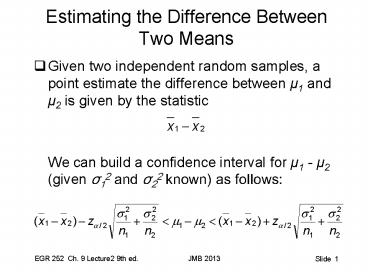Estimating the Difference Between Two Means - PowerPoint PPT Presentation
Title:
Estimating the Difference Between Two Means
Description:
Title: Walpole 8th edition Chapter 9 Lecture 2 Author: Moody and Burtner Last modified by: Joan Burtner Created Date: 10/5/2004 9:31:40 PM Document presentation format – PowerPoint PPT presentation
Number of Views:81
Avg rating:3.0/5.0
Title: Estimating the Difference Between Two Means
1
Estimating the Difference Between Two Means
- Given two independent random samples, a point
estimate the difference between µ1 and µ2 is
given by the statistic - We can build a confidence interval for µ1 - µ2
(given s12 and s22 known) as follows
2
Example 9.10 Page 286
- Find a 96 Confidence Interval
- xbarA 36 mpg sA 6 nA 50
- xbarB 42 mpg sB 8 nB 75
- a0.04 a/2 0.02 Z0.02 2.055
Calculations 6 2.055 sqrt(64/75 36/50) lt
(µB - µA) lt 6 2.055 sqrt(64/75
36/50) Results 3.4224 lt (µB - µA) lt 8.5776
96 CI is (3.4224, 8.5776)
3
Differences Between Two Means Variances Unknown
- Case 1 s12 and s22 unknown but equal
- Pages 287 and 288
- Where,
- Note v n1 n2 -2
4
Differences Between Two Means Variances Unknown
(Page 290)
- Case 2 s12 and s22 unknown and not equal
- Where,
- WOW!
5
Estimating µ1 µ2
- Example (s12 and s22 known)
- A farm equipment manufacturer wants to compare
the average daily downtime of two sheet-metal
stamping machines located in two different
factories. Investigation of company records for
100 randomly selected days on each of the two
machines gave the following results - x1 12 minutes x2 10 minutes
- s12 12 s22 8
- n1 n2 100
- Construct a 95 C.I. for µ1 µ2
6
Solution
- 95 CI Z.025 1.96
- (12-10) 1.96sqrt(12/100 8/100) 2 0.8765
- 1.1235 lt µ1 µ2 lt 2.8765
- Interpretation If CI contains 0, then µ1 µ2
may be either positive or negative (cant say
that one is larger than the other) however,
since the CI for µ1 µ2 is positive, we conclude
µ1 must be larger than µ2 .
7
µ1 µ2 si2 Unknown
- Example (s12 and s22 unknown but equal)
- Suppose the farm equipment manufacturer was
unable to gather data for 100 days. Using the
data they were able to gather, they would still
like to compare the downtime for the two
machines. The data they gathered is as follows - x1 12 minutes x2 10 minutes
- s12 12 s22 8
- n1 18 n2 14
- Construct a 95 C.I. for µ1 µ2
8
Solution
- Governing Equations
- Calculations
- t0.025,30 2.042 sp2
((1712)(138))/30 10.267 sp 3.204 - 2 2.0423.204sqrt(1/18 1/14) 2 2.3314
- -0.3314 lt µ1 µ2 lt 4.3314
- Interpretation
- Since this CI contains 0, we cant conclude µ1 gt
µ2 .
9
Paired Observations
- Suppose we are evaluating observations that are
not independent - For example, suppose a teacher wants to compare
results of a pretest and posttest administered to
the same group of students. - Paired-observation or Paired-sample test
- Example murder rates in two consecutive years
for several US cities. Construct a 90 confidence
interval around the difference in consecutive
years.
10
Calculation of CI for Paired Data
- Example 9.13 We have 20 pairs of values. We
calculate the difference for each pair. We
calculate the sample standard deviation for the
difference values. The appropriate equations are - µd µ1 µ2
- Based on the data in Table 9.1 Dbar -0.87
Sd 2.9773 n20 - We determine that a (1-0.05)100 CI for µd is
-2.2634 lt µd lt 0.5234
Interpretation If CI contains 0, then µ1 µ2
may be either positive or negative (cant say
that one is larger than the other). Since this
CI contains 0, we conclude there is no
significant difference between the mean TCDD
levels in the fat tissue.
11
C.I. for Proportions
- The proportion, P, in a binomial experiment may
be estimated by - where X is the number of successes in n trials.
- For a sample, the point estimate of the parameter
is - The mean for the sample proportion is
- and the sample variance
12
C.I. for Proportions
- An approximate (1-a)100 confidence interval for
p is - Large-sample C.I. for p1 p2 is
- Interpretation If the CI contains 0
13
Interpretation of the Confidence Interval
Significance
- If the C.I. for p1 p2 (-0.0017, 0.0217), is
there reason to believe there is a significant
decrease in the proportion defectives using the
new process? - What if the interval were (0.002, 0.022)?
- What if the interval were (-0.900, -0.700)?
14
Determining Sample Sizes for Developing
Confidence Intervals
- Requires specification of an error amount ?
- Requires specification of a confidence level
- Examples in text
- Example 9.3 Page 273
- Single sample estimate of mean
- Example 9.15 Page 299
- Single sample estimate of proportion































